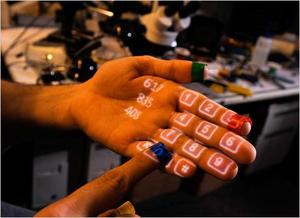In the trenchesONR’s augmented-reality project progresses
The Office of Naval Research (ONR) yesterday demonstrated the next phase of an augmented-reality project which will change the way soldiers view operational environments — literally

Augmented reality keypad projected onto a hand // Source: tufts.edu
The Office of Naval Research (ONR) demonstrated the next phase of an augmented-reality project yesterday, 23 August, in Princeton, New Jersey, which will change the way soldiers view operational environments — literally.
ONR says it has completed the first year of a multi-year augmented-reality effort, developing a system that allow trainees to view simulated images superimposed on real-world landscapes. One example of augmented reality technology can be seen in sports broadcasts, which use it to highlight first-down lines on football fields and animate hockey pucks to help TV viewers with interpreting plays.
With major advances in this same technology, ONR envisions preparing the future force and providing the Navy and Marine Corps a first-of-its-kind training solution.
“The training capability augmented reality offers is revolutionary, because you can train in a real-world environment and inject simulated forces or entities,” said Dr. Peter Squire, ONR program manager for Human Performance Training and Education. “This will decrease costs and allow trainers to execute a wide range of scenarios with a fraction of the support required for live training. You can construct simulations to meet your training needs and objectives rather than going to a training facility, enabling users to train anywhere.”
The technology uses advanced software algorithms and multiple sensors to determine a trainee’s viewpoint, while virtual aircraft, targets and munitions effects are inserted into the real-world view through glasses, goggles or a visor. ONR is currently working with Small Business Innovation Research (SBIR)/Small Business Technology Transfer (STTR) programs and industry to develop augmented-reality headgear.
One application for augmented reality is Joint Terminal Attack Controller (JTAC) training. JTACs work on the ground to manage the attacks of nearby combat aircraft. Today, live JTAC training is conducted on a few specialized ranges with static targets and limited reconfigurability. This training also requires aircraft flight hours, range time and live artillery — all of which are scarce resources. ONR says that augmented reality offers huge cost savings, since the only element needed is the terrain: aircraft, targets, and effects can all be computer generated.
Researchers working on the project will present papers at ISMAR 2012, the International Symposium on Mixed and Augmented Reality, 5-8 November, in Atlanta, as well as at I/ITSEC 2012, the Interservice/Industry Training, Simulation, and Education Conference, 3-6 December, in Orlando, Florida.
In December, ONR will select the most promising head-mounted SBIR/STTR displays for further development. In 2013 ONR will conduct two more demonstrations of the augmented-reality technology in Quantico, Virginia, and Camp Pendleton, California.
